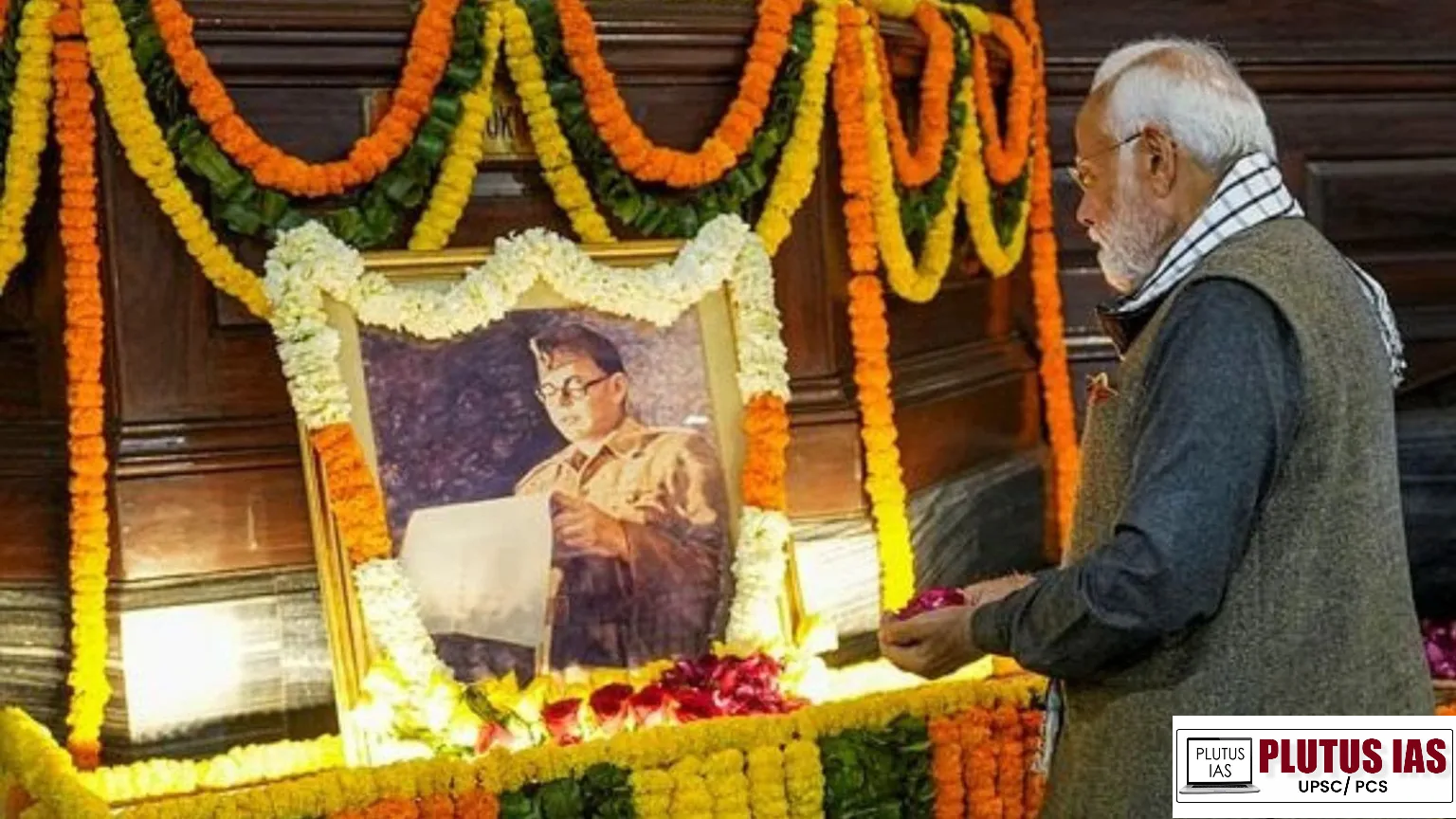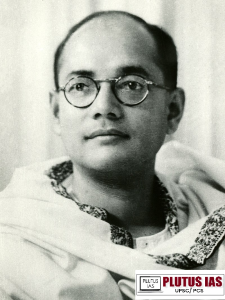01 Feb Beyond the Headlines: The Untold Story of Subhas Chandra Bose’s Fight for Freedom
SYLLABUS MAPPING:
GS-1- History and Culture -Beyond the Headlines: The Untold Story of Subhas Chandra Bose’s Fight for Freedom
FOR PRELIMS:
Key facts about INA Forward Bloc and other important organisations related to set-up by Subhas Chandra Bose’s
FOR MAINS
Why in the news?

What is Parakarm diwas?
Parakram Diwas (also known as Netaji Jayanti) is a national observance in India that celebrates the birth anniversary of Netaji Subhas Chandra Bose on 23 January. The day is dedicated to honouring his immense contributions to India’s struggle for independence. The name Parakram Diwas translates to the Day of Valor, highlighting Netaji’s bravery, leadership, and unwavering commitment to the cause of Indian independence. Bose is especially remembered for his role as the leader of the Indian National Army (INA), which fought against British colonial rule, and for founding the Azad Hind Government. The day was officially recognized as Parakram Diwas in 2021, marking his 124th birth anniversary, and it is celebrated annually with various events across India, especially in states like West Bengal, Odisha, Assam, Jharkhand, and Tripura. While it is celebrated with patriotic fervour, the naming of the day as Parakram Diwas has sparked some controversy, with certain political leaders and Netaji’s family members calling for the day to be renamed as Deshprem Divas (Day of Patriotism) or Deshanayak Divas (Day of National Hero).

Subhas Chandra Bose:
1. Early Life and Background:
Birth and Family: Subhas Chandra Bose was born on 23 January 1897 in Cuttack, Odisha, into a well-off Bengali family. His father, Janakinath Bose, was a prominent lawyer, and his mother, Prabhavati Devi, was deeply religious and nurturing.
Education: Bose was an exceptional student, excelling in academics from an early age. He completed his early education in Cuttack and later attended Presidency College in Kolkata. His academic brilliance earned him a spot at Cambridge University in England, where he graduated with a degree in B.A. (Honours) in Philosophy. He also cleared the Indian Civil Services (ICS) exam, which was seen as a prestigious career path.
Cultural Influence: Growing up in the culturally rich environment of Bengal, Bose was inspired by the Bengal Renaissance and deeply influenced by the nationalist movements of the time. His admiration for the freedom struggle grew through the teachings of leaders like Swami Vivekananda and Bankim Chandra Chattopadhyay.
2. Subhas Chandra Bose’s Contribution to India’s Freedom:
Involvement with the Indian National Congress: Subhas Chandra Bose initially aligned with the Indian National Congress (INC), led by Mahatma Gandhi. However, Bose was more radical in his approach compared to Gandhi’s philosophy of non-violence. Bose firmly believed that India’s independence could only be achieved through a more aggressive, militant strategy.
Disagreement with Gandhi and INC Leadership: As Bose’s views on achieving independence clashed with Gandhi and the INC leadership, he formed his own faction within the Congress, advocating for the complete independence of India (Purna Swaraj) and the use of force if necessary.
Electoral Success: In 1938, Bose was elected the President of the Indian National Congress, but his differences with Gandhi and the Congress leadership led to his resignation in 1939. He believed that the Congress was not doing enough to push for India’s freedom.
The Azad Hind Movement: Bose’s ultimate goal was India’s independence through armed struggle. His legacy in the freedom movement is most strongly tied to the formation of the Azad Hind Fauj (Indian National Army) and his leadership of the Azad Hind Government during World War II.
3. Subhas Chandra Bose and the Indian National Army (INA):
Formation of INA: Bose’s leadership of the Indian National Army (INA) stands as one of his most significant contributions to the Indian freedom struggle. During his time in Southeast Asia, Bose sought help from Nazi Germany and Imperial Japan to form the INA, comprising Indian prisoners of war and expatriates.
INA’s Role in the War: The INA fought alongside the Japanese against British forces in India and Southeast Asia. Though the INA ultimately did not succeed in liberating India, its efforts played a crucial role in inspiring a sense of nationalism and military resistance against British rule.
INA’s Symbolism: The INA became a symbol of unity and courage in the face of adversity, and its efforts directly influenced the post-war independence movement. Netaji’s famous slogan, “Give me blood, and I will give you freedom,” inspired many to join the cause.
4. Subhas Chandra Bose and the Forward Bloc:
Formation of the Forward Bloc: In 1939, after his resignation from the INC, Subhas Chandra Bose formed the Forward Bloc, a left-wing political group within the Indian National Congress. This group aimed to unite all anti-colonial forces and push for immediate and total independence.
The Role of the Forward Bloc: While the Forward Bloc initially struggled to gain widespread support, it became an important platform for Bose to mobilize the masses and promote a more militant form of resistance against British colonial rule. The organization also focused on working-class issues, which Bose believed were crucial for building a strong national movement.
Ideological Differences: The Forward Bloc was ideologically distinct from the main Congress party. Bose’s vision for India’s future included strong central governance, industrialization, and a more assertive foreign policy, in contrast to the moderate approach favoured by leaders like Gandhi and Nehru.
5. Subhas Chandra Bose’s Activities Abroad:
Journey to Germany and Japan: After being placed under house arrest by the British authorities, Bose escaped India in 1941 and travelled to Germany and Japan to seek support for India’s independence. He believed that the Axis powers, despite their problematic ideologies, could help India fight British imperialism
Collaboration with Axis Powers: In Germany, Bose formed ties with Nazi officials, including Adolf Hitler, and later moved to Japan, where he secured military support for his vision of an independent India. While he did not fully endorse Nazi ideologies, he believed that the Axis powers could help weaken British rule in India.
Role in the Indian National Army (INA): In Japan, Bose took charge of the INA, which fought against British forces in Burma and parts of India. He also established the Azad Hind Government, which declared war on Britain and Japan’s allies.
Mysterious Disappearance: Bose’s efforts came to a sudden halt after Japan’s defeat in World War II. In 1945, he is believed to have died in a plane crash in Taiwan, though this has been the Subject of much speculation and controversy. Many still believe that Bose may have survived and spent his final years in secrecy.
Overall impact of Subhas Chandra Bose’s ideology in Post-Independence India:
1. Nationalism and Patriotism: Subhas Chandra Bose’s unwavering commitment to India’s independence and his call for complete independence (Purna Swaraj) inspired generations of Indians. His iconic slogan, “Give me blood, and I will give you freedom,” symbolizes courage and unity in the fight for freedom.
2. Legacy of the Indian National Army (INA): The Indian National Army (INA), led by Bose, became a symbol of militant nationalism. Though it did not lead to immediate independence, it sparked a spirit of resistance against British rule, complementing other independence efforts.
3. Rejection of Non-Violence: Bose’s militant approach to India’s freedom struggle, emphasizing self-reliance and strength, contrasted with Gandhi’s non-violence but contributed to a multifaceted independence movement, highlighting the role of assertive nationalism.
4. Influence on Post-Independence Politics: Bose’s vision for a strong, centralized India shaped post-independence policy on defence, security, and industrialization, leaving a lasting impact on India’s nation-building and development.
5. Inspiration for Post-Independence Leaders: Bose’s ideology of strong governance and national unity inspired radical and left-wing political leaders, especially in West Bengal, influencing their approach to consolidating India’s democracy and addressing regional divisions.
6. Symbol of Unity in Diversity: Bose’s leadership of the INA, which included diverse linguistic, cultural, and religious groups, epitomized his belief in unity in diversity, a core value in India’s national identity.
7. Continued Debate on His Disappearance: The mystery of Bose’s disappearance after World War II continues to spark debates. Many believe he may have survived and secretly worked for India’s cause, keeping his legacy alive through ongoing research and public interest.
8. Promoting National Resilience: Bose’s life, marked by sacrifices and setbacks, exemplified resilience and determination. His persistence in the face of adversity serves as a motivation for overcoming challenges in nation-building and pursuing the greater good of India.
Download Plutus IAS Current Affairs (Eng) 01st Feb 2025
Conclusion:
Subhas Chandra Bose’s impact on post-independence India is profound. His contributions transcend mere political actions; they embody the spirit of resistance, freedom, and sacrifice. Bose’s ideology continues to shape India’s national identity, political thinking, and the moral fibre of the country’s struggle for justice, making him an enduring figure in Indian history. His call for complete independence, his leadership of the Indian National Army, and his efforts to strengthen India’s sovereignty continue to inspire political discourse and are integral to understanding India’s historical and modern identity.
Prelims Questions:
Q. Which of the following statements are correct about Parakram Diwas?
1. Parakram Diwas is celebrated annually on 23 January to mark the birth anniversary of Subhas Chandra Bose.
2. Parakram Diwas was officially recognized in 2020 as a national observance in India.
3. The day is celebrated with patriotic fervour across India, especially in states like West Bengal, Odisha, and Assam.
Select the correct answer using the code given below:
A. 1 and 2 only
B. 2 and 3 only
C. 1 and 3 only
D. 1, 2 and 3
Answer: C
Mains Questions:
(250 words, 15 marks)




No Comments